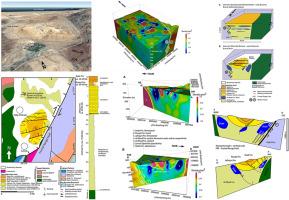阿曼苏丹国东北部断陷后苏努布构造的结构:基于测绘、三维重力反演和页岩迁移
IF 2.2
4区 地球科学
Q2 GEOSCIENCES, MULTIDISCIPLINARY
引用次数: 0
摘要
我们研究了鲜为人知的苏努布构造的构造演化,该构造与赛赫哈特穹隆北缘和伸展型额岭断层(阿曼东北部)有关。苏努布构造位于向东北方向延伸的额岭断层的右旋横断段和悬壁上。该断层活跃于坎帕尼亚期(?)/马斯特里赫特期至始新世早期(I期)和始新世中/晚期至中新世早期(II期)。利用 175 个测站和绘图进行的重力反演表明(1) 苏努布构造可能有 1200-1350 米深,主要由厚达 900 米的坎帕尼亚(?)/中新世硅质碎屑岩 Al-Khod Formation(包括页岩)和一些上覆的古新世石灰岩填充。(2) 无法描绘盆地底部。(3) 构造下部是一个盆地(苏努布沉积盆地),以次垂直至陡峭的接触面为界。(4) 苏努布构造的上部是一个盆地褶皱,在地表以下 300 米处呈碗状,称为苏努布碗。(5) 碗状构造被径向断层和五条 ∼E/W 向横断面断层切割。苏努布构造形成于第一区间,是一个深层横断同步沉积盆地。在第二期期间,温和的沉积后构造和粘塑性页岩运动形成了今天地表可见的碗状构造。重力反演描绘了 Al-Khod Formation 内页岩迁移的可能证据。虽然没有发现碳氢化合物,但苏努布结构可以作为类似结构中碳氢化合物迁移和储存的模拟。本文章由计算机程序翻译,如有差异,请以英文原文为准。

Architecture of the post-obductional Sunub Structure, northeastern Sultanate of Oman: Based on mapping, 3D gravity inversion and shale migration
We examined the structural evolution of the poorly understood Sunub Structure, which is associated with the northern margin of the Saih Hatat Dome and the extensional Frontal Range Fault (northeastern Oman). The Sunub Structure is located at a dextral transtensional segment and on the hanging wall of the NNE-striking Frontal Range Fault. The fault was active during the Campanian(?)/Maastrichtian to early Eocene (Interval I) and mid-/late Eocene to early Miocene (Interval II). Gravitational inversion using 175 stations and mapping shows: (1) The Sunub Structure is possibly >1200–1350 m deep and filled mostly with the >900-m-thick Campanian(?)/Maastrichtian siliciclastic Al-Khod Formation, including shale, and some overlying Paleogene limestones. (2) The bottom of the basin cannot be depicted. (3) The lower part of the structure is a basin (Sunub Sedimentary Basin), bounded by sub-vertical to steep contacts. (4) The upper part of the Sunub Structure is a basin fold displaying a bowl-shape down to ∼300 m below the surface, referred to as the Sunub Bowl. (5) The bowl is cut by radial faults and five ∼E/W-striking transverse faults. The Sunub Structure formed during Interval I as a deep transtensional, syn-depositional basin. Gentle post-depositional tectonics during Interval II and visco-plastic shale movements produced the present-day bowl-shape that is visible at the surface. Gravitational inversion depict possible evidence for shale migration within the Al-Khod Formation. Although no hydrocarbons are present, the Sunub Structure can serve as an analogue for hydrocarbon migration and storage in similar structures.
求助全文
通过发布文献求助,成功后即可免费获取论文全文。
去求助
来源期刊

Journal of African Earth Sciences
地学-地球科学综合
CiteScore
4.70
自引率
4.30%
发文量
240
审稿时长
12 months
期刊介绍:
The Journal of African Earth Sciences sees itself as the prime geological journal for all aspects of the Earth Sciences about the African plate. Papers dealing with peripheral areas are welcome if they demonstrate a tight link with Africa.
The Journal publishes high quality, peer-reviewed scientific papers. It is devoted primarily to research papers but short communications relating to new developments of broad interest, reviews and book reviews will also be considered. Papers must have international appeal and should present work of more regional than local significance and dealing with well identified and justified scientific questions. Specialised technical papers, analytical or exploration reports must be avoided. Papers on applied geology should preferably be linked to such core disciplines and must be addressed to a more general geoscientific audience.
 求助内容:
求助内容: 应助结果提醒方式:
应助结果提醒方式:


